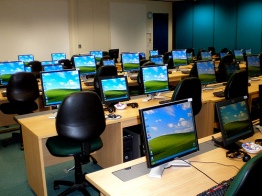This fall Living Sky School Division, a collection of schools in rural Saskatchewan, embarked on the first steps of a one-to-one initiative. In June schools were invited to submit a proposal for participation in a year of teacher training to prepare for one-to-one the following year. Eleven schools submitted a proposal and five schools were accepted. The selection was based on a cross section of the school division (rural, urban, small, large, high school, elementary, PreK-12 and the quality of their statement of intent, which had to include:
- A statement of why the school wishes to participate in the program. This could include the school’s philosophical statement about technology and learning and/or how one-to-one has the potential to advance student learning.
- An outline of a suggested training schedule (after-school, lunch hour, etc – limited release time will be available for small group or individual work)
- An expression of understanding of how technology use involves incorporating division initiatives such as UbD, Differentiated Instruction and Assessment.
- A demonstrated commitment by ALL staff to participate fully in the training program
- Attendance at workshop and other training sessions
- Completion of learning tasks
- Sharing knowledge and insights
- Participation in the creation of the manual to be used in the implementation of one-to-one in the school
- A statement that indicates an understanding that the school or the school division may choose to terminate the training program at anytime.
Each teacher in the five schools that have been selected, Major, NBCHS, Spiritwood High School, Connaught Community School, and Luseland School will receive a netbook, and copy of the book, 1-To-1 Learning: Laptop Programs that Work.
I will be responsible for guiding and facilitating the professional learning program and so far have had conversations with two school staffs about what the learning will look like. Division initiatives are of primary importances – especially our focus on Differentiated Instruction – as are school goals. During our initial conversations I talked about social media, personal learning networks and how I would like them to personalize the learning as much as possible. The learning will evolve around the use of social media to facilitate connection, conversation and collaboration.
We are also undertaking a simplified form of action research to document our progress and to reflect on our learning. Teachers have been asked to create a question, to take some action based on the question and to document their learning.
The netbooks should be here within the month and we will begin our learning journey. This journey will look different in each school and may lead to a variety of decisions made at the end. A staff may decide that they do not want student one-to-one; they may decide that it is more appropriate in certain grades, or they might want a two-to-one or three-to-one ratio at the end of the year. It is the school’s decision – but it will be made based on hands-on knowledge, research and learning.







 I am working with a group of teachers, one from each school as well the teacher-librarians in our
I am working with a group of teachers, one from each school as well the teacher-librarians in our 


